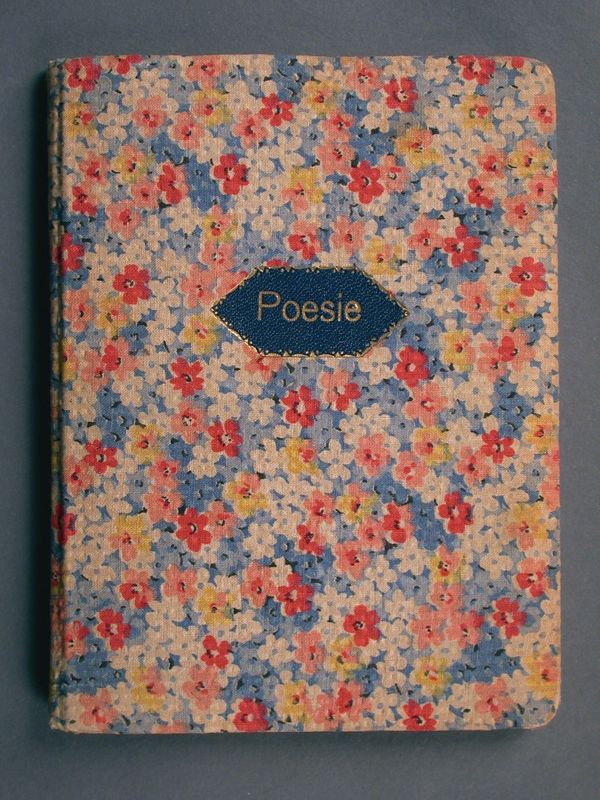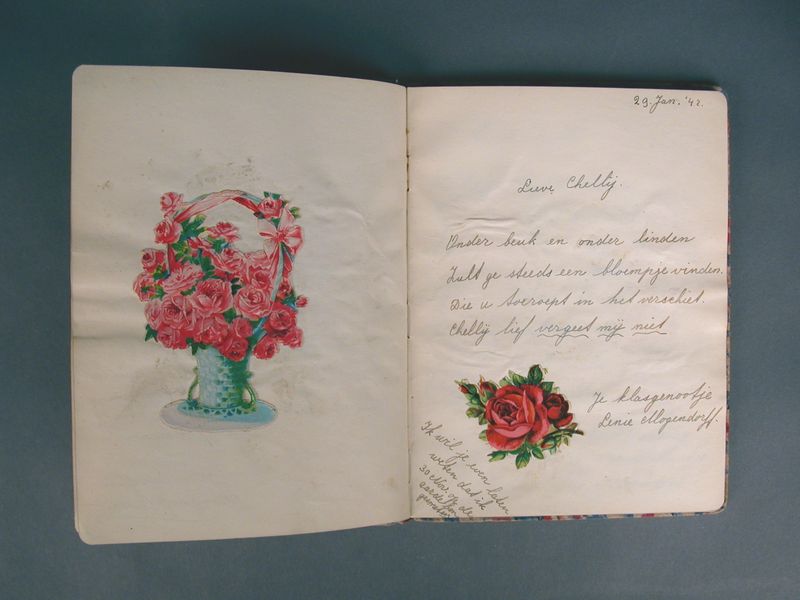Overview
- Description
- Hand covered autograph and poetry notebook used by Rachel (Chelly) de Groot while in hiding in the Netherlands. It was recovered by her brother Louis after the war.
- Credit Line
- United States Holocaust Memorial Museum Collection, Gift of Louis de Groot
Physical Details
- Language
- Dutch
- Genre/Form
- Photo albums.
- Extent
-
1 folder
- Physical Description
- Rectangular notebook with cardboard covers covered in blue, red, pink white, and yellow flowers. A small blue cloth hexagon with the word Poesie is adhered on the front center. Inside are bound unlined pages with handwritten inscriptions and adhered cut out pictures.
- Dimensions
- overall: Height: 6.875 inches (17.463 cm) | Width: 5.375 inches (13.653 cm) | Depth: 0.375 inches (0.953 cm)
- Materials
- overall : cardboard, cloth, paper, ink, adhesive, graphite, paint
Rights & Restrictions
- Conditions on Access
- There are no known restrictions on access to this material.
- Conditions on Use
- Material(s) in this collection may be protected by copyright and/or related rights. You do not require further permission from the Museum to use this material. The user is solely responsible for making a determination as to if and how the material may be used.
Keywords & Subjects
- Topical Term
- Deportees--Netherlands--Amsterdam--Biography. Hidden children (Holocaust)--Netherlands--Biography. Holocaust, Jewish (1939-1945)--Netherlands--Personal narratives. Holocaust victims--Netherlands--Biography. Jewish children in the Holocaust--Netherlands--Biography. Jews--Persecution--Netherlands--Biography. World War, 1939-1945--Underground movements--Netherlands--Personal narratives, Jewish.
Administrative Notes
- Holder of Originals
-
United States Holocaust Memorial Museum
- Legal Status
- Permanent Collection
- Provenance
- Donated to the United States Holocaust Memorial Museum in 2003 by Louis de Groot
- Funding Note
- The cataloging of this artifact has been supported by a grant from the Conference on Jewish Material Claims Against Germany.
- Record last modified:
- 2023-09-15 09:26:40
- This page:
- https://collections.ushmm.org/search/catalog/irn513936
Download & Licensing
- In Copyright - Use Permitted
- Terms of Use
- This record is not digitized and cannot be downloaded online.
In-Person Research
- Request 7 Days in Advance of Visit
- Plan a Research Visit
-
Request in Shapell Center Reading Room
Bowie, MD
Contact Us
Also in Louis de Groot family collection
The collection consists of beads, beadwork, two containers, a calendar, and an autograph book relating to the experiences of Rachel de Groot and her brother Louis de Groot during the Holocaust while in hiding in the Netherlands, and a wall hanging relating to the experiences of their mother, Sophia de Groot, before the Holocaust in Arnhem. The collection also includes original and copyprint photographs related to the wartime experiences of Louis de Groot. Includes photos of a child who was in hiding with de Groot. Some of these materials may be combined into a single collection in the future.
Date: 1938-1945
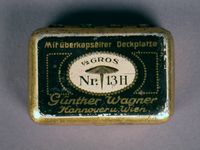
Tin box used to store beads by a Dutch Jewish girl in hiding
Object
Günther Wagner tack box used by Rachel “Chelly” de Groot from November 1942 to April 1944 and recovered by her brother Louis after the war. Chelly used the box to store unfinished red glass beadwork and small glass beads that she used to make handicrafts. Nazi Germany invaded the Netherlands on May 10, 1940, and implemented anti-Jewish restrictions. In July 1942, the Germans began mass deportations. On November 16, 1942, Chelly, 15, Louis, 13, and their parents Meijer and Sophia left Arnhem and went into hiding after the Dutch police warned them of a raid. Meijer and Sophia hid in Amsterdam while Chelly and Louis moved around to different locations. In summer or fall 1943, Chelly went to Amsterdam to live with her parents. In December, Louis was sent to Lemmer to live with the Onderweegs family. In February 1944, Dirk Onderweegs visited and offered to take Chelly to a safer hiding place. On April 8, 1944, four days before Dirk was to return, Chelly and her parents were denounced and arrested. They were sent to Westerbork transit camp, then to Auschwitz. Chelly and Sophia were killed upon arrival in Auschwitz on May 22, 1944. Meijer was selected for a work detail and was killed on September 30, 1944. Louis remained in hiding with Onderweegs until liberation in mid-April 1945.
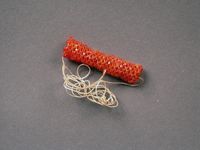
Unfinished red glass beadwork made by a Dutch Jewish girl in hiding
Object
Unfinished length of red glass beadwork made by Rachel “Chelly” de Groot from November 1942 to April 1944 and recovered by her brother Louis after the war. The beadwork may have been for a bracelet. Nazi Germany invaded the Netherlands on May 10, 1940, and implemented anti-Jewish restrictions. In July 1942, the Germans began mass deportations. On November 16, 1942, Chelly, 15, Louis, 13, and their parents Meijer and Sophia left Arnhem and went into hiding after the Dutch police warned them of a raid. Meijer and Sophia hid in Amsterdam while Chelly and Louis moved around to different locations. In summer or fall 1943, Chelly went to Amsterdam to live with her parents. In December, Louis was sent to Lemmer to live with the Onderweegs family. In February 1944, Dirk Onderweegs visited and offered to take Chelly to a safer hiding place. On April 8, 1944, four days before Dirk was to return, Chelly and her parents were denounced and arrested. They were sent to Westerbork transit camp, then to Auschwitz. Chelly and Sophia were killed upon arrival in Auschwitz on May 22, 1944. Meijer was selected for a work detail and was killed on September 30, 1944. Louis remained in hiding with Onderweegs until liberation in mid-April 1945.
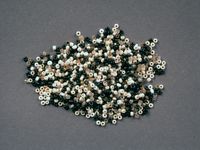
Small black, white, gold, and clear glass beads used by a Dutch Jewish girl in hiding
Object
Several tiny black, white, gold, and clear glass beads used by Rachel “Chelly” de Groot from November 1942 to April 1944 and recovered by her brother Louis after the war. Chelly used the beads to make handicrafts. Nazi Germany invaded the Netherlands on May 10, 1940, and implemented anti-Jewish restrictions. In July 1942, the Germans began mass deportations. On November 16, 1942, Chelly, 15, Louis, 13, and their parents Meijer and Sophia left Arnhem and went into hiding after the Dutch police warned them of a raid. Meijer and Sophia hid in Amsterdam while Chelly and Louis moved around to different locations. In summer or fall 1943, Chelly went to Amsterdam to live with her parents. In December, Louis was sent to Lemmer to live with the Onderweegs family. In February 1944, Dirk Onderweegs visited and offered to take Chelly to a safer hiding place. On April 8, 1944, four days before Dirk was to return, Chelly and her parents were denounced and arrested. They were sent to Westerbork transit camp, then to Auschwitz. Chelly and Sophia were killed upon arrival in Auschwitz on May 22, 1944. Meijer was selected for a work detail and was killed on September 30, 1944. Louis remained in hiding with Onderweegs until liberation in mid-April 1945.
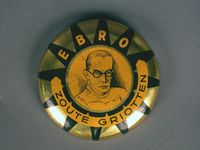
Tin candy container and lid used to store beads by a Dutch Jewish girl in hiding
Object
Ebro candy tin used by Rachel “Chelly” de Groot from November 1942 to April 1944 and recovered by her brother Louis after the war. Chelly used the box to store small red glass beads that she used to make handicrafts. Nazi Germany invaded the Netherlands on May 10, 1940, and implemented anti-Jewish restrictions. In July 1942, the Germans began mass deportations. On November 16, 1942, Chelly, 15, Louis, 13, and their parents Meijer and Sophia left Arnhem and went into hiding after the Dutch police warned them of a raid. Meijer and Sophia hid in Amsterdam while Chelly and Louis moved around to different locations. In summer or fall 1943, Chelly went to Amsterdam to live with her parents. In December, Louis was sent to Lemmer to live with the Onderweegs family. In February 1944, Dirk Onderweegs visited and offered to take Chelly to a safer hiding place. On April 8, 1944, four days before Dirk was to return, Chelly and her parents were denounced and arrested. They were sent to Westerbork transit camp, then to Auschwitz. Chelly and Sophia were killed upon arrival in Auschwitz on May 22, 1944. Meijer was selected for a work detail and was killed on September 30, 1944. Louis remained in hiding with Onderweegs until liberation in mid-April 1945.
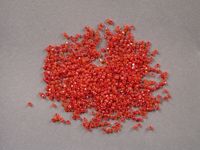
Small red glass beads used by a Dutch Jewish girl in hiding
Object
Small red glass beads used by Rachel “Chelly” de Groot from November 1942 to April 1944 and recovered by her brother Louis after the war. Chelly used the beads to make handicrafts. Nazi Germany invaded the Netherlands on May 10, 1940, and implemented anti-Jewish Semitic restrictions. The Germans began mass deportations in July 1942. On November 16, 1942, Chelly, 15, Louis, 13, and their parents Meijer and Sophia left Arnhem and went into hiding after the Dutch police warned them of a raid. Meijer and Sophia hid in Amsterdam while Chelly and Louis moved around to different locations. In summer or fall 1943, Chelly went to Amsterdam to live with her parents. In December, Louis was sent to Lemmer to live with the Onderweegs family. In February 1944, Dirk Onderweegs visited and offered to take Chelly to a safer hiding place. On April 8, 1944, four days before Dirk was to return for Chelly, Chelly and her parents were denounced and arrested. They were sent to Westerbork transit camp, then to Auschwitz. Chelly and Sophia were killed upon arrival in Auschwitz on May 22, 1944. Meijer was selected for a work detail and was killed on September 30, 1944. Louis survived the Holocaust in hiding with the Onderweegs family.
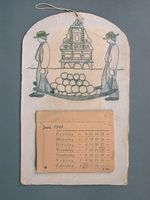
Handmade 1944 calendar made by a hidden Dutch Jewish girl for her brother
Object
Handmade calendar made by 16 year old Rachel “Chelly” de Groot for her 14 year old brother Louis while they were in hiding in separate places in the Netherlands in 1944. Chelly copied an image of the Alkmaar Cheese Market, depicting two men carrying cheese in front of the Alkmaar Weigh House. Louis received the calendar after Dirk Onderweegs, the resistance member Louis was staying with, visited his family in February 1944. The calendar displays June 1944 because Louis and the Onderweegs had to flee their home in June, after they were turned into the Gestapo for their resistance activity. Germany occupied the Netherlands in May 1940 and implemented anti-Jewish restrictions. In July 1942, the Germans began mass deportations. On November 16, 1942, Chelly, 15, Louis, 13, and their parents Meijer and Sophia left Arnhem and went into hiding. Meijer and Sophia hid in Amsterdam while Chelly and Louis moved around to different locations. In summer/fall 1943, Chelly went to Amsterdam to live with her parents. In December, Louis was sent to Lemmer to live with the Onderweegs family. In February 1944, Dirk Onderweegs visited and offered to take Chelly to a safer hiding place. On April 8, 1944, four days before Dirk was to return, Chelly and her parents were denounced and arrested. They were sent to Westerbork transit camp, then to Auschwitz. Chelly and Sophia were killed upon arrival in Auschwitz on May 22, 1944. Meijer was selected for a work detail and was killed on September 30, 1944. Louis remained in hiding with Onderweegs until liberation in mid-April 1945.
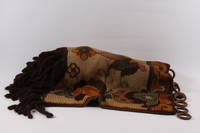
Hand knitted floral wall hanging made prewar by a Dutch Jewish woman
Object
Floral patterned, fringed wall hanging created by Sophia Swaab de Groot in 1938 or 1939 in Arnhem, Netherlands, and recovered by her son Louis after the war. Sophia made the wall hanging to protect the wall behind the living room couch. She worked on it for hours over several nights and used a paper pattern to create it. Germany occupied the Netherlands in May 1940 and implemented anti-Jewish restrictions. In July 1942, the Germans began mass deportations. On November 16, 1942, Chelly, 15, Louis, 13, and their parents Meijer and Sophia left Arnhem and went into hiding. Meijer and Sophia hid in Amsterdam while Chelly and Louis moved around to different locations. In summer/fall 1943, Chelly went to Amsterdam to live with her parents. In December, Louis was sent to Lemmer to live with the Onderweegs family. In February 1944, Dirk Onderweegs visited and offered to take Chelly to a safer hiding place. On April 8, 1944, four days before Dirk was to return, Chelly and her parents were denounced and arrested. They were sent to Westerbork transit camp, then to Auschwitz where Chelly and Sophia were killed upon arrival on May 22, 1944. Meijer was selected for a work detail and was killed on September 30, 1944. Louis remained in hiding with Onderweegs until liberation in mid-April 1945.

